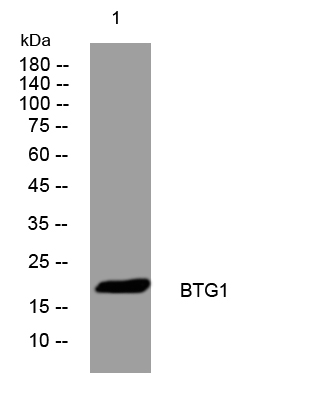BTG1 rabbit pAb
- Catalog No.:YT6828
- Applications:WB
- Reactivity:Human;Mouse;Rat
- Target:
- BTG1
- Fields:
- >>RNA degradation
- Gene Name:
- BTG1
- Protein Name:
- BTG1
- Human Gene Id:
- 694
- Human Swiss Prot No:
- P62324
- Mouse Gene Id:
- 12226
- Mouse Swiss Prot No:
- P62325
- Rat Gene Id:
- 29618
- Rat Swiss Prot No:
- Q63073
- Immunogen:
- Synthesized peptide derived from human BTG1 AA range: 27-77
- Specificity:
- This antibody detects endogenous levels of BTG1 at Human/Mouse/Rat
- Formulation:
- Liquid in PBS containing 50% glycerol, 0.5% BSA and 0.02% sodium azide.
- Source:
- Polyclonal, Rabbit,IgG
- Dilution:
- WB 1:500-2000
- Purification:
- The antibody was affinity-purified from rabbit antiserum by affinity-chromatography using epitope-specific immunogen.
- Concentration:
- 1 mg/ml
- Storage Stability:
- -15°C to -25°C/1 year(Do not lower than -25°C)
- Molecular Weight(Da):
- 19kD
- Background:
- This gene is a member of an anti-proliferative gene family that regulates cell growth and differentiation. Expression of this gene is highest in the G0/G1 phases of the cell cycle and downregulated when cells progressed through G1. The encoded protein interacts with several nuclear receptors, and functions as a coactivator of cell differentiation. This locus has been shown to be involved in a t(8;12)(q24;q22) chromosomal translocation in a case of B-cell chronic lymphocytic leukemia. [provided by RefSeq, Oct 2008],
- Function:
- developmental stage:Its expression is associated with the early G1 phase of the cell cycle.,disease:A chromosomal aberration involving BTG1 may be a cause of a form of B-cell chronic lymphocytic leukemia. Translocation t(8;12)(q24;q22) with MYC.,function:Anti-proliferative protein.,similarity:Belongs to the BTG family.,
- Subcellular Location:
- nucleus,cytoplasm,
- June 19-2018
- WESTERN IMMUNOBLOTTING PROTOCOL
- June 19-2018
- IMMUNOHISTOCHEMISTRY-PARAFFIN PROTOCOL
- June 19-2018
- IMMUNOFLUORESCENCE PROTOCOL
- September 08-2020
- FLOW-CYTOMEYRT-PROTOCOL
- May 20-2022
- Cell-Based ELISA│解您多样本WB检测之困扰
- July 13-2018
- CELL-BASED-ELISA-PROTOCOL-FOR-ACETYL-PROTEIN
- July 13-2018
- CELL-BASED-ELISA-PROTOCOL-FOR-PHOSPHO-PROTEIN
- July 13-2018
- Antibody-FAQs
- Products Images

- Western blot analysis of lysates from A549 cells, primary antibody was diluted at 1:1000, 4°over night



